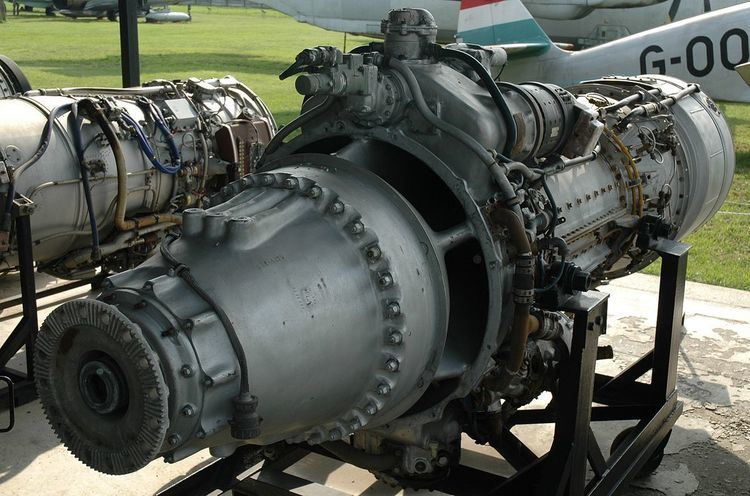 | ||
The Ivchenko AI-20 is a Soviet turboprop engine developed by the Ivchenko design bureau in the 1950s. It has been built in large numbers, serving as the powerplant for the Antonov An-12 transport and the Ilyushin Il-18 airliner.
Contents
Design and development
The AI-20 was the first gas turbine engine developed by the design bureau led by Oleksandr Ivchenko based at Zaporizhia, USSR, which had previously concentrated on small piston engines such as the Ivchenko AI-14 and AI-26 radials. It was designed as a prospective powerplant for the new, large Ilyushin Il-18 airliner and the Antonov An-10, to be powered by four turboprops, in competition with the Kuznetsov NK-4 engines. Both engines were tried out on the pre-production batch of 20 Il-18s, but the Ivchenko engine was chosen for full production, possibly due to a crash caused by an in-flight failure of an NK-4 engine, and possibly due to the desire for the engines of the Ukrainian An-10 to also be built in Ukraine.
The Il-18B was powered by four Ivchenko AI-20A Series 1 turboprops, each providing a takeoff power of 2,985 kW (4,000 shp) and sustained power of 2,090 kW (2,800 shp) at cruise altitude. Early Il-18A production had initially been fitted with Kuznetsov NK-4 engines, but they were soon swapped out for AI-20s. Later Il-18B production featured AI-20A Series 2 engines, with the same power ratings but technical improvements thus older machines were updated with the Series 2 powerplants. The AI-20s drove four-bladed variable-pitch reversible props with a diameter of 4.5 meters (14 feet 9 inches), featuring prominent prop spinners, and hydraulic actuation for prop pitch. The engines were mounted above the wing and featured integrated fire extinguishers. The engines were started with electric motors, the power for the motors being provided by a ground cart.
The AI-20 is a single-shaft turboprop with a ten-stage axial compressor and a three-stage power turbine, and is designed to run at a constant speed. A big problem with early production engine was the poor reliability of the AI-20 engines, which had a time between overhauls (TBO) in the range of 600 to 750 hours. The AI-20K engine variant was finally introduced, with a TBO of 2,000 hours – unimpressive by modern standards, but a big improvement. One issue that was never addressed was noise; turboprops are relatively noisy and high noise levels were a real problem for the passengers. As mentioned, the overhaul life of the engine was initially poor compared with contemporary western engines, being reported as 600–750 hours in 1964, but was later improved by continuous development to 8,000 hours, with a service life of 22,000 hours in the AI-20D series 5M.
Serial production was carried out at Zaporozhye (Motor Sich) and at Perm, USSR in 1958, also being built under licence in China as the WJ-6. About 14,000 AI-20s have been built in total.
Variants
AI-20
WJ-6
Specifications (AI-20D series 5)
Data from Jane's All The World's Aircraft 1993–94 and Motor Sich website
General characteristics
Width: 842 mm (33.15 in)
Height:1,180 mm (46.46 in)
